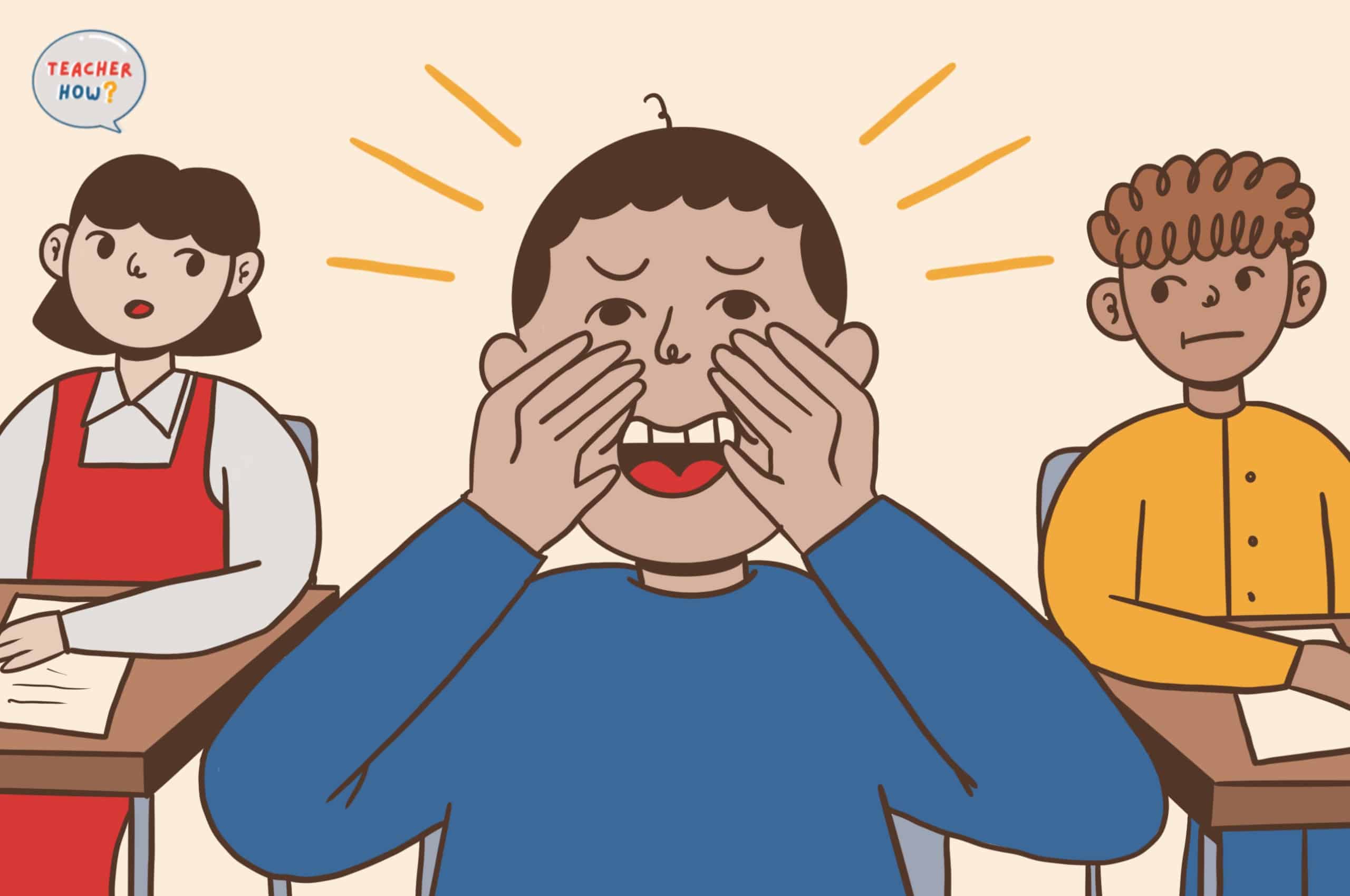Are your students finding it hard to contain their excitement, so they resort to blurting out answers? While calling out can be a natural response, in this instance, it might be challenging for a teacher to maintain order in their classroom. So how do you stop your students from blurting out while not discouraging them from participating altogether?
Here are some tips on how to stop students from blurting or calling out during class:
- Explain why blurting is a problem.
- Set classroom expectations.
- Provide fair opportunities for students to express themselves.
- Assign consequences to blurting.
- Use behavior modifiers.
- Help students monitor their behavior.
- Arrange an experiential learning opportunity.
- Engage the parents.
Blurts or calling out (which will be used interchangeably throughout this article) may result from impulsivity, stress, or other social factors. This article will explore a few strategies to minimize this behavior and promote a well-managed classroom.
1. Explain Why Blurting Is a Problem
Most students aren’t aware that blurting causes problems in the classroom. In lower grades, learners are excited to share their thoughts or comments without waiting for their turn. However, this behavior is not only reserved for kindergarten students since it can happen at all learning levels.
All teachers enjoy interactive lessons. It’s incredible to watch your students’ enthusiasm to learn and participate in discussions. However, frequent calling out can dampen a classroom’s spirit.
Therefore, the first step to managing calling out among your students is by creating awareness. Learners need to know that blurting is wrong and why it can create issues in a learning environment. Moreover, they should learn how to manage the urge to call out and the potential consequences of their actions.
Here are some ways to create awareness on blurting among your students:
Read Books on Blurting
Books aren’t only rich sources of information, but they can also make for an enjoyable, interactive pastime in the classroom. Learners in lower grades love it when their teacher reads stories aloud during class. Therefore, reading books that focus on blurting would help introduce the subject.
Picture books are the best option for kindergarten and other lower-grade students. They capture the learners’ attention, especially when you let them look at the pictures and give their opinions.
Here are four excellent picture books to use (available on Amazon.com):
- My Mouth is a Volcano – This is an exciting book that narrates a boy’s struggles with blurting and how he overcame the behavior. It helps children learn to manage their thoughts and words without interrupting. It’s also ideal for learners between kindergarten and grade three (5 to 8 years old).
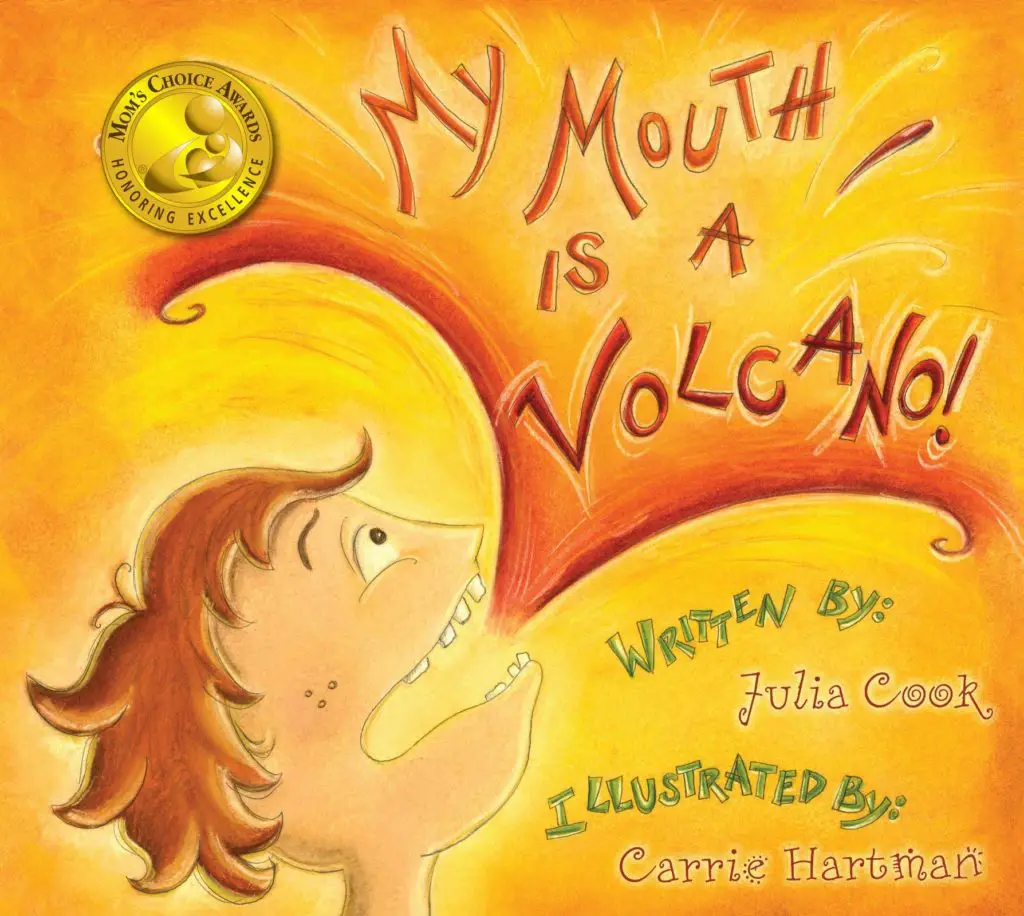
- It’s Hard to Be a Verb – It is an engaging book by Julia Cook, who also wrote ‘My Mouth is a Volcano.’ It shows a boy’s (Louis) challenges controlling himself due to ADHD and his mum’s techniques to help him. It’s one of the best resources for teaching children with impulse control issues.
- What Were You Thinking? – Authored by Bryan Steve, this book is ideal for students with impulse control issues. It is a hilarious story of a third-grader who can’t control his impulses and how the adults in his life come to his rescue. It teaches learners how to overcome this behavior in four steps.
- Nonstop Talker – This is a perfect book for preschoolers and learners up to grade one. The featured narration revolves around an owl who talks nonstop (until she loses her voice). Therefore, it teaches children the importance of listening and allowing others to speak.
Discuss the Topic With Your Students
Another effective way to teach your students about blurting is through discussions. You can do this after introducing the topic through a story. Then, divide the learners into small groups, allowing them to brainstorm ideas on the causes and consequences of blurting out.
While the students discuss the topic, move around the classroom to observe their interactions. Identify learners who are quick to blurt out their ideas and those who shy away. You can either call them out or take note of their names for individualized strategies to improve their behavior.
Create a Blurt (Anchor) Chart
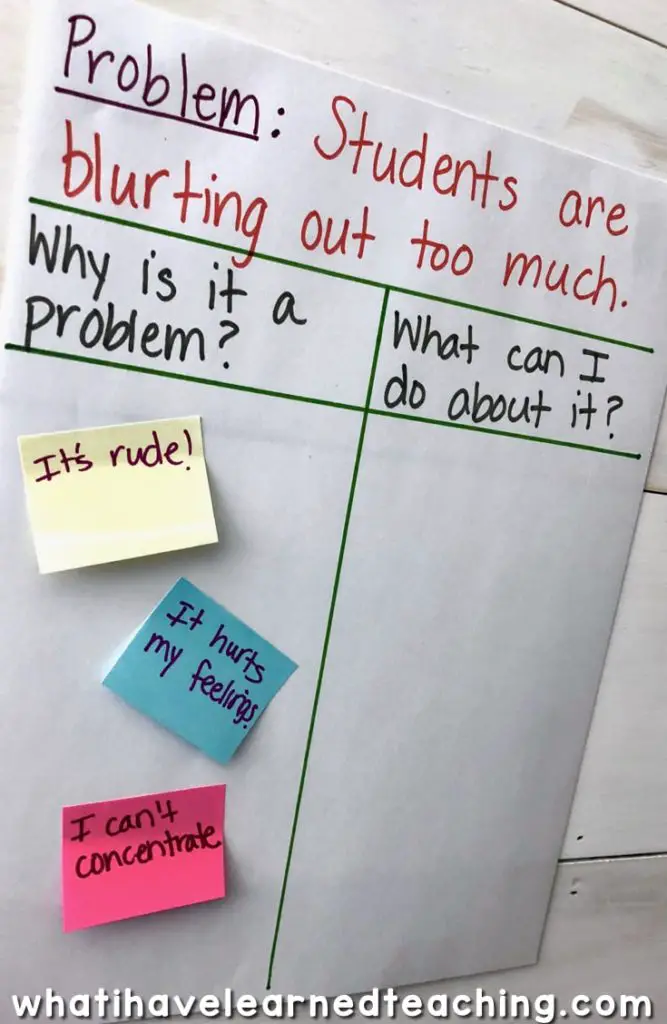
After introducing blurting as a problem and allowing for some student discussions, you can create a chart as a guide on the topic. Apart from outlining the subject, the blurt chart will be a visual reminder to help students throughout the process. It’s advisable to engage them in creating this chart to enhance their responsibility.
The blurt chart can include the following sections:
- Why blurting is wrong – For example, it is impolite, rude, insensitive of others’ feelings, unfair, or not appropriate.
- Reasons why students blurt – For example, they have impulse control issues, don’t know it is wrong, or have social-related conditions (like ADHD).
- The consequences of blurting – It disrupts learning in the classroom.
- A student’s responsibility in changing their behavior
- Ways to help students stop blurting
Here are a few tips on how to create a blurt chart with your students:
- Allow your learners to share their ideas on why blurting is a problem.
- Identify individual students who are yelling out their answers. Call them out to demonstrate how blurting is interruptive.
- Alternatively, let the students write down their ideas on sticky notes that you can attach to the blurt chart.
2. Set Classroom Expectations
After mutual discussions on how blurting can create an unpleasant experience for both teacher and pupils, come up with clear classroom expectations. Again, like with the anchor chart, let your students participate and give ideas on the topic.
Learners should know that you expect them not to call out but raise their hands in instances when they:
- Want to answer a question
- Want to ask a question
- Need to go to the bathroom
- Are feeling uncomfortable about something
However, they should also have a clear understanding that they can immediately talk to the teacher when:
- There’s an emergency
- They feel unsafe
If you’ve noticed individual student cases with serious blurting issues, jot down detailed expectations. Therefore, you can create mini blurt charts tailored for them, indicating more specific expectations. It’s essential to have a personalized approach for any student who lags with adjusting to the classroom’s expectations.
3. Provide Fair Opportunities for Students to Express Themselves
Every child wants to be heard. Even those we label as ‘shy and timid’ would like to vocalize their opinions and ideas – given that they are in a comfortable environment. By lecturing students about not calling out in class, it may appear that we are stifling their voices and contributions, which, of course, is not the intention. To avoid such misperception, we need to provide our students with opportunities where they do actually get to ask, answer, and share whatever thoughts they had when they were so eager to blurt out earlier.
A simple example to illustrate this point would include saying, “I will explain the instructions as clearly as I can now, but if you still have questions or comments after listening to all the information, you will have the opportunity to share your thoughts at the end.”
Students should come to realize that instead of interrupting others in that particular moment, there will be a time and place provided for them to express themselves soon.
Another dynamic that students quickly pick up on is the principle of fairness. There are characters in every class that are more extroverted, and it can seem like these students always have something to say. Consequently, the teacher could be forgiven for calling on these individuals to answer and ask questions more frequently than the other students. This imbalance in participation may elude the teacher, but for the student(s) who had little to say throughout the lesson, a sense of injustice may creep in.
An area of my practice that students and parents consistently commend is my emphasis on fairness. When students are aware of your commitment to equal opportunities, they are more likely to respect and believe in your practices. Hence, my goal is to give every student a fair opportunity to share what is on their minds, whether they have their hand raised.
One way to achieve this is by leaving the selection process to chance. Fortunately, there are many tools online to aid with this process. The Random Selector on Class Dojo would be my recommendation. All that is required from the teacher is to input the class list with everyone’s name and then click ‘random’ whenever you wish to call on a student in the class.
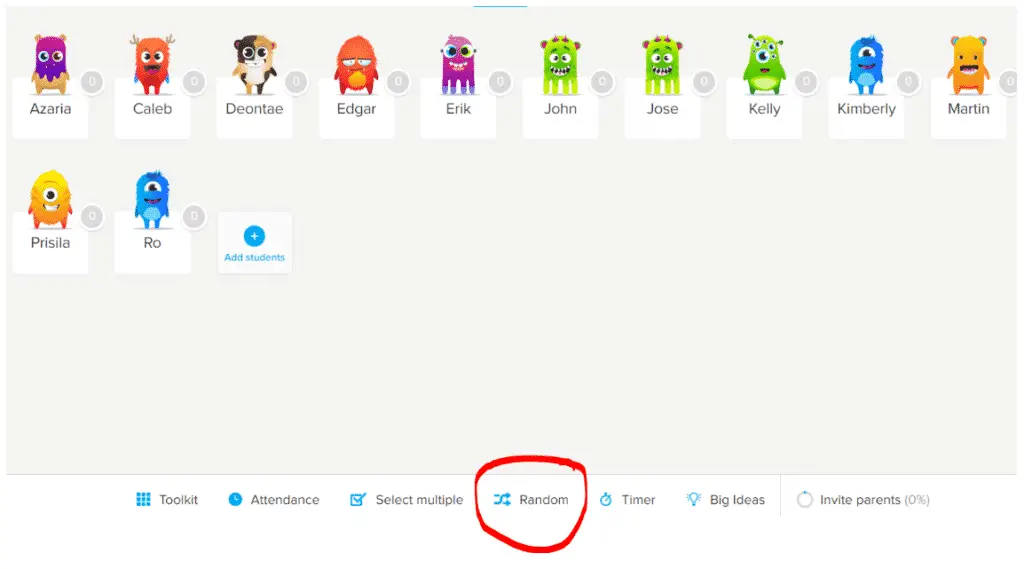
4. Assign Consequences to Blurting
Once all the students have understood both the classroom’s and their individual expectations on calling out, establishing consequences for breaking these ‘rules’ is recommended. It’s best to communicate these repercussions at the beginning of a new term and allow students to give ideas on what constitutes a fair consequence.
Although you can inform them of these consequences orally, writing them down is crucial. Remember the anchor (blurt) chart? It will come in handy as a visual reminder of the likely ramifications for students who repeatedly call out.
You can create a ‘consequence card’ that you can stick on your students’ desks for personalized cases. Therefore, they’ll be seeing it every time they want to blurt out and remember that some repercussions will follow. Moreover, this card will foster responsibility.
Some appropriate repercussions include:
- Blurting out for the first time – give a nonverbal reminder such as a signal or standing beside the student
- Blurting out the second time – provide a verbal reminder
- Blurting out the third time – have a reflection or teacher-talking time after class
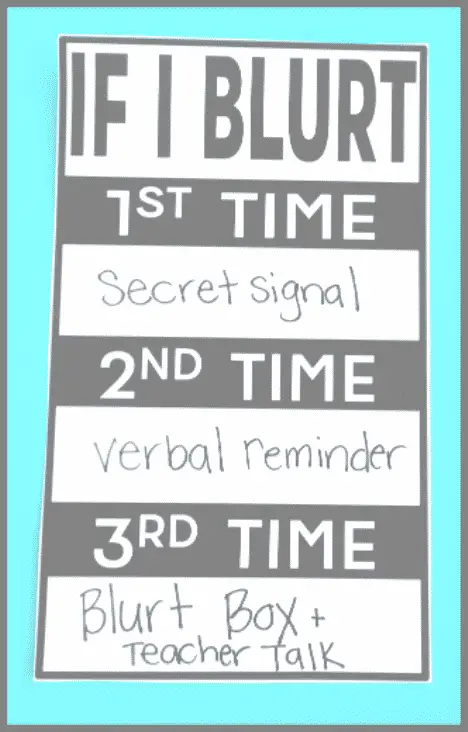
It’s crucial to follow up on the written consequences to let the students know that you’re serious about them. However, if these consequences don’t seem to work, you can always revise them or develop a new strategy to better help your students modify their behavior.
5. Use Behavior Modifiers
Not all learners will have issues controlling themselves. Therefore, you’ll find that only one or maybe two students are still calling out after establishing the expectations and consequences. When this happens, it’s advisable to identify strategies to modify their behavior.
Some students may be frequent blurters since they suffer from behavioral disorders, including ADHD (Attention Deficit Hyperactivity Disorder), anxiety, and ODD (Oppositional Defiant Disorder). Therefore, it’s essential to be mindful of such learners and establish whether they have any underlying conditions before dishing out repercussions. This approach will make it easier to develop the best behavior-modifying intervention.
Here are some approaches that I have found effective in curbing blurting:
Blurt Buttons Approach
It is a class management strategy that involves picking buttons and filling a jar. Using these readily available materials is fun and interactive, allowing students to learn how to stop calling out more practically. Additionally, it’s a rewarding approach where students earn goodies for mastering non-blurting behavior.
To get started, you’ll need:
- Two clear plastic jars
- A handful of beans or buttons
- Labels
You can download a Blurts Button Resource Pack comprising of set-up resources and a teacher direction sheet to guide you.
After assembling the resources, here’s how to implement the strategy:
- Set up the glass jars by labeling them. One should have the “Blurt Buttons” label, while the second one should have several reward strips (at different) heights.
- Distribute the buttons among the students. Each learner can have 3-5 buttons depending on how expressive they are.
- Explain how the approach will work – verbally or practically.
- When students blurt out, they should pick one of their buttons and place it in the jar labeled “Blurt Buttons .” The rest of the learners should fill the ‘Rewards Jar’ with the unused buttons. If these buttons reach a rewards strip, they earn a treat.
The resource pack provides ideas on what goodies to reward your students. However, you can also come up with alternatives according to your preferences. The Blurt Buttons approach is very efficient since the students will be eager to fill the Rewards Jar and restrain from calling out. Moreover, working as a whole class encourages teamwork.
You can also use beans or other practical items in this class management approach. Here’s a YouTube video demonstrating how to use blurt beans to stop your students from calling out:
Stop-and-Jot Approach
Some learners blurt out because they fear forgetting their ideas (or answers) if they don’t say them out loud immediately. The stop-and-jot approach will be an excellent solution in this instance. Using it will teach your students how to express themselves without interrupting others and control their impulsivity.
Before you start, have a conversation with each talkative learner and tell them that you’ve noted their behavior. If they aren’t aware, let them know that there’s a problem and that you’re willing to help them. However, use a positive approach by pointing out that you’re proud of their willingness to participate in class and express their ideas.
Let the student take this intervention positively and not as a punishment. Then, explain that they’ll write down ideas every time they feel like blurting them out, and you’ll check them later.
Provide post-it pads (or sticky notes) that the student can use to jot down their ideas. You can allow them to choose their favorite colors and shapes to make the activity more enjoyable. Then, when they write down on the pads, they can place them on the edge of the desk.
Finally, at convenient times throughout the lesson, the student can share what they have written on the pads, or alternatively, you can pick and read the notes at your choosing without having to stop the lesson – just as long as you show some acknowledgment to the student who wrote the note.
Positive Reinforcement
Instead of giving attention to the student who blurts out most frequently, focus on those who raise their hands. You can call out their names and praise them for waiting for their turn to answer. Moreover, you can have a reward system where they can earn prizes and treats, such as raffle tickets or cool stationery.
Positive reinforcement on learners who don’t interrupt others will send a message to those who do that it’s rewarding to wait for their turn. They will understand that they won’t receive any attention for blurting out. As a result, they’ll try to manage their impulsivity to get rewards.
Active Listening
Active listening is one of the social skills that learners should acquire at an early age. The skill enables students to be attentive while others talk and wait for their turn to speak. You can train them to be active listeners by having them place their hands on their laps and focus on the speaker when you call out one student to answer a question.
You can help learners acquire active listening skills by teaching them:
- To pay attention when someone is speaking.
- Not to interrupt the speaker.
- To be patient.
- To save any questions and comments until the end.
6. Help Students Monitor their Behavior
Once you’ve introduced a behavior-modifying approach, it’s crucial to follow up and monitor the student(s). You can also teach your learners to track their behavior to enhance responsibility and accountability. Various behavior monitoring strategies can be applicable, including the following:
Cooperative Learning Strategies
These interventions work best when students are discussing in groups. They help learners practice how to give turns and work as a team. Moreover, they enable shy students to gain confidence since their audience reduces from the whole class to just a handful of their peers.
Here are a few cooperative learning strategies that you can use to stop students from blurting out during group discussions:
- Talking tokens – are tokens that you give each student in the group at the beginning of the discussion. A learner will give back a talking token after they’ve voiced their thoughts while others listened. They can’t say anything if they’ve run out of tokens, so all students have equal chances of speaking and listening.
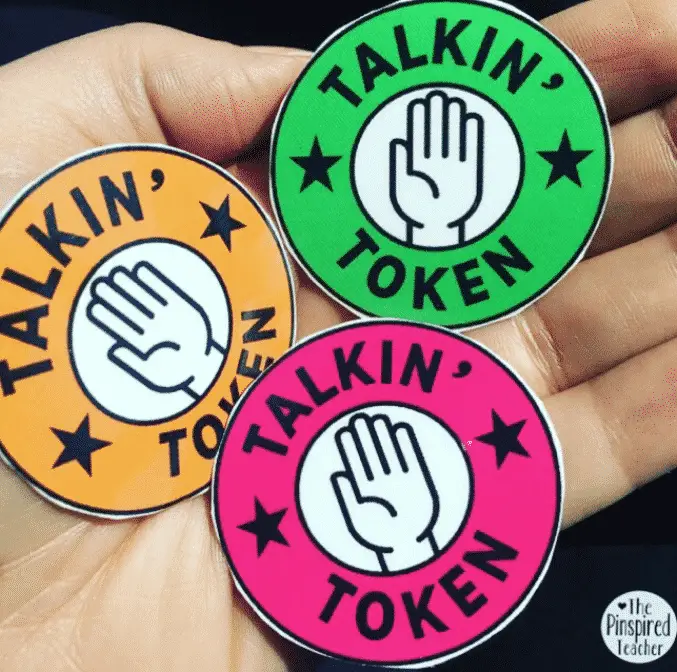
- A talking object – is an interactive tool that can include a microphone, a beanbag, a ball, or anything that can be held. In most cases, there’s only one talking object per group. Therefore, only the student holding the talking object can speak at a given time.
Keeping Record
This is an individualized behavior monitoring strategy. The student in question will have the weekly timetable chart printed on their desk. It will be their responsibility to make tallies each time they blurt out. This way, the student can keep a running record of when and how often they called out.
Before initiating this strategy, let the student know that they’ll show behavior improvement when they reduce the number of tallies on their chart. Again, you can incentivize them with a reward should they achieve a specific number of blurts at the end of the day/week.
7. Arrange an Experiential Learning Opportunity
As the name suggests, experiential learning is the process of learning through experience. The argument is that doing and experiencing something is far more meaningful to the learner than the more conventional methods of reading and listening to information.
I would second this notion! Throughout my teaching practice, I have observed how student engagement and retention are far greater when the learning is more hands-on and active. To find out more about experiential learning in general, check out this video:
Experiential learning applies to all areas of education, even when teaching students not to blurt out. As the facilitator, the teacher is responsible for designing the learning experience to maximize its significance. Here is how this might look when addressing the issue of students calling out:
- Set students into small groups and ask each group to prepare a presentation for the class. The topic of the presentations is not necessarily important here but for the purpose of the exercise, be sure to group the students who blurt out frequently together. This is our control group.
- Give each group time to prepare and ask the control group to rehearse outside. This is so that while the control group is out, you can brief the other students that they will be part of the role-play to make them aware of your intentions so that the exercise does not get out of hand.
- In particular, select a few responsible students to take on the role of ‘blurters.’ These students will call out and interrupt the control group during their presentation.
- The activity will be most effective if the control group is unaware of the ongoing learning experience, so prompt the other students to remain tight-lipped.
- Once these steps have been followed, groups can take turns to present their presentation.
- When it comes to the turn of the control group, the assigned blurters should perform their roles and call out routinely.
- As the teacher, show acknowledgment for the blurting but do not stop it. Instead, ask the control group to simply carry on with their presentation while the interruptions continue.
- Once every group has presented, the all-important reflection stage should be carried out. The focus will be on the reflections of the control group. Ask them:
- How easy it was to present to the class while some students were blurting out?
- Do they think the rest of the class learned anything from their presentation?
- How did the continuous blurting out make them feel?
- Finally, reveal to the control group that this was a role-play exercise and that the other students in the class, especially the assigned blurters, were following your directions.
- If students are to reap the benefits of experiential learning, reflection is crucial, so be sure to provide plenty of time for ideas to be shared and connections to be made.
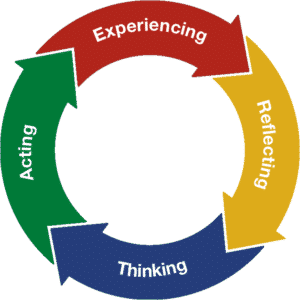
Experiential learning can be just the insight that certain students need to internalize the problems of blurting out.
8. Engage the Parents
Engaging with parents on most school-related issues can be helpful on two main fronts. Firstly, they develop a better understanding of your expectations and how you operate in class, so they are more likely to reinforce your practices with their child at home. The student will be getting help and reminders to not blurt out from both teacher and parents.
Secondly, parents can provide more insight into why their child might be acting a certain way. For instance, there may be issues at home which would explain the changes in behavior at school. Or the student may have a condition that you hadn’t previously known about. In both cases, communicating with parents and gathering more information will only benefit you in choosing the best intervention approach for the student.
You can inform the parents if and when their child shows behavior improvements for extra merit and appreciation.
Conclusion
Stopping students from blurting out during class is a behavioral-modifying process that requires time, empathy, and patience.
By following the approaches mentioned here, you’ll be able to maintain order and quiet in your classroom, however strong the students’ urge to call out may be.
Sources
- Institute of Education Sciences: Reducing Behavior Problems in the Elementary School Classroom
- What I Have Learned: 6 Ways to Stop Students from Blurting Out in the Classroom
- ResearchGate: Reducing off-Task Behaviors Using an Action Research Method with One-Case Study
- Psych Guides: Behavioral Disorder Symptoms, Causes and Effects
- Teach Starter: Blurt Buttons – Classroom Management Strategy
- Teachers Brain: Blurt Beans: Classroom Management Strategies
- YouTube: HELP! My Students Won’t Stop Talking!
- Differentiated Teaching: Simple Interventions for Students who Blurt
- Verywell Mind: What Is Active Listening?
- We Are Teachers: Tried-and-True Teacher Secrets to Stop Students from Blurting Out
- ClassDojo
- Connect. Design. Learn: Randomize with ClassDojo
- The Pinspired Teacher: 9 Guaranteed Ways to Stop Students from Blurting Out
- Experiential Learning Institute: What is Experiential Learning

